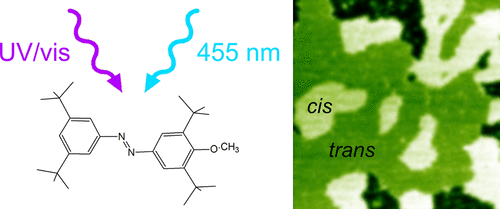Our official English website, www.x-mol.net, welcomes your
feedback! (Note: you will need to create a separate account there.)
Reversible and Efficient Light-Induced Molecular Switching on an Insulator Surface
ACS Nano ( IF 15.8 ) Pub Date : 2018-01-18 00:00:00 , DOI: 10.1021/acsnano.7b08624 Simon Jaekel 1 , Antje Richter 2 , Robert Lindner 2 , Ralf Bechstein 2 , Christophe Nacci 1 , Stefan Hecht 3 , Angelika Kühnle 2 , Leonhard Grill 1
ACS Nano ( IF 15.8 ) Pub Date : 2018-01-18 00:00:00 , DOI: 10.1021/acsnano.7b08624 Simon Jaekel 1 , Antje Richter 2 , Robert Lindner 2 , Ralf Bechstein 2 , Christophe Nacci 1 , Stefan Hecht 3 , Angelika Kühnle 2 , Leonhard Grill 1
Affiliation

|
Prototypical molecular switches such as azobenzenes exhibit two states, i.e., trans and cis, with different characteristic physical properties. In recent years various derivatives were investigated on metallic surfaces. However, bulk insulators as supporting substrate reveal important advantages since they allow electronic decoupling from the environment, which is key to control the switching properties. Here, we report on the light-induced isomerization of an azobenzene derivative on a bulk insulator surface, in this case calcite (101̅4), studied by atomic force microscopy with submolecular resolution. Surprisingly, cis isomers appear on the surface already directly after preparation, indicating kinetic trapping. The photoisomerization process is reversible, as the use of different light sources results in specific molecular assemblies of each isomer. The process turns out to be very efficient and even comparable to molecules in solution, which we assign to the rather weak molecular interaction with the insulator surface, in contrast to metals.
中文翻译:

绝缘子表面上可逆和高效的光诱导分子开关
原型分子开关,诸如偶氮苯表现出两个状态,即,反式和顺式,具有不同特性的物理性质。近年来,在金属表面上研究了各种衍生物。但是,大块绝缘体作为支撑衬底显示出重要的优势,因为它们允许电子与环境解耦,这是控制开关特性的关键。在这里,我们报道了在大体积绝缘子表面上的偶氮苯衍生物(在这种情况下为方解石(101̅4))的光诱导异构化,通过亚分子分辨率的原子力显微镜研究。令人惊讶的是,顺式制备后,异构体已经直接出现在表面上,表明存在动力学捕集。光异构化过程是可逆的,因为使用不同的光源会导致每种异构体发生特定的分子组装。事实证明,该过程非常有效,甚至可以与溶液中的分子相媲美,与金属相比,我们将其归因于与绝缘子表面的较弱的分子相互作用。
更新日期:2018-01-18
中文翻译:

绝缘子表面上可逆和高效的光诱导分子开关
原型分子开关,诸如偶氮苯表现出两个状态,即,反式和顺式,具有不同特性的物理性质。近年来,在金属表面上研究了各种衍生物。但是,大块绝缘体作为支撑衬底显示出重要的优势,因为它们允许电子与环境解耦,这是控制开关特性的关键。在这里,我们报道了在大体积绝缘子表面上的偶氮苯衍生物(在这种情况下为方解石(101̅4))的光诱导异构化,通过亚分子分辨率的原子力显微镜研究。令人惊讶的是,顺式制备后,异构体已经直接出现在表面上,表明存在动力学捕集。光异构化过程是可逆的,因为使用不同的光源会导致每种异构体发生特定的分子组装。事实证明,该过程非常有效,甚至可以与溶液中的分子相媲美,与金属相比,我们将其归因于与绝缘子表面的较弱的分子相互作用。











































 京公网安备 11010802027423号
京公网安备 11010802027423号